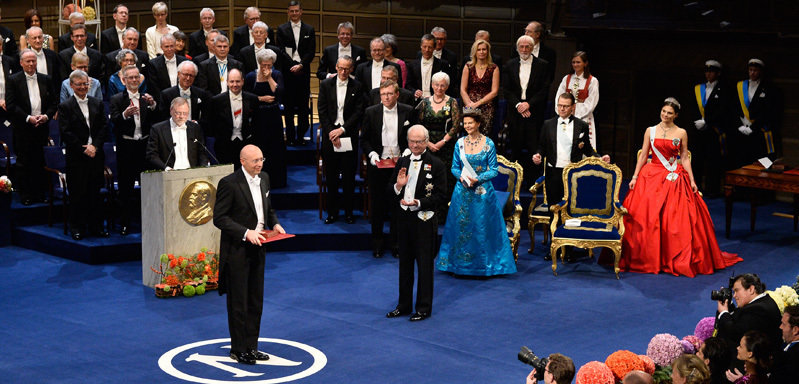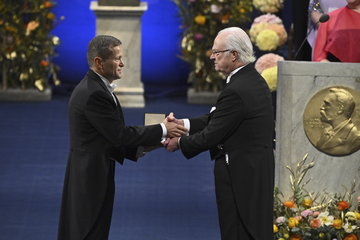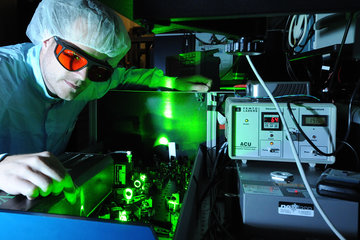Stefan Hell awarded Nobel Prize in Chemistry in Stockholm
The Director at the Max Planck Institute for Biophysical Chemistry in Göttingen shares the prize with Eric Betzig and William E. Moerner.
Stefan Hell received the Nobel Prize in Chemistry in 2014 on Wednesday afternoon during a festive ceremony inside Stockholm Concert Hall. The director of the Max Planck Institute for Biophysical Chemistry received his gold medal and diploma from the hand of King Carl XVI Gustaf of Sweden. The physicist received the award for his pioneering work in the field of ultra high-resolution fluorescence microscopy. Hell succeeded in radically overcoming the resolution limit of conventional optical microscopes – a breakthrough that has enabled new ground-breaking discoveries in biological and medical research.

The Nobel Prize winners are announced by the Royal Swedish Academy of Sciences. Traditionally, this is done in the second week of October. Hell, who will be accompanied by family, close friends, co-workers and fellow scientists, was just sitting at his desk in his office, engrossed in a paper, when the call from Stockholm reached him and he found out that he had been awarded with this year’s Nobel Prize in Chemistry. "Of course your first thought is that this is a hoax”, Hell remembers. But the moment of shock quickly gave way to a “tremendous feeling of joy”. The physicist says: "I am enormously gratified that my work and that of my co-workers has received the highest distinction for scientific research". Max Planck President Martin Stratmann emphasized: "This is a wonderful recognition of the pioneering achievements of Stefan Hell. A researcher is recognized who has had the courage to overcome obstacles, pave new paths and challenge seemingly incontestable beliefs. This is the only way that truly new things can be achieved in science." With Stefan Hell, four scientists of the Max Planck Institute for Biophysical Chemistry have now been awarded the highest scientific distinction.
With the invention of the STED (Stimulated Emission Depletion) microscopy experimentally realized by Hell in 1999, he has revolutionized light microscopy. Conventional light microscopes reach their resolution limit when two similar objects are closer than 200 nanometres (millionth of a millimetre) to each other because the diffraction of light blurs them to a single image feature. This limit discovered by Ernst Abbe – and chiselled in stone in a memorial in Jena (Germany) – had been considered an insurmountable hurdle. The same limit by diffraction also applies to fluorescence microscopy which is frequently used in biology and medicine.
Molecules of the cell are labelled with fluorescent dyes and "switched on" with laser light of a specific wavelength, so that they glow. If the molecules are closer together than 200 nanometres, however, they also blur into also to a washed out spot. For biologists and physicians, this meant a massive restriction – because for them, the observation of much smaller structures in living cells is decisive.
The 51-year-old physicist Stefan Hell was the first to radically overcome the resolution limit of light microscopes – with an entirely new concept. STED microscopy, invented and developed by him to application readiness, is the first focused light-microscopy method which is no longer fundamentally limited by diffraction. It allows an up to ten times greater detailed observation in living cells and makes structures visible that are much smaller than 200 nanometres. "Back then I intuitively felt that something has not been thought through thoroughly," Hell recalls.
In order to overcome the phenomenon of light diffraction, he and his team applied a trick. The focal spot of the fluorescence excitation beam is accompanied by a doughnut-shaped "STED beam" that switches off fluorophores at the spot periphery by effectively confining them to the ground state.
In contrast, molecules at the doughnut centre can dwell in the fluorescence "on" state and fluoresce freely. The resolution is typically improved by up to ten times compared with conventional microscopes, meaning that labelled protein complexes with separation of only 20-50 nanometres can be discerned. As the brightness of the STED beam is increased, the spot in which molecules can fluoresce is further reduced in size. As a consequence, the resolution of the system can be increased, in principle, to molecular dimensions.
But not only "snapshots" are possible with the new STED microscope. Even life processes inside living cells can be observed "live" with nanometre resolution. The team around Hell was able to film, in real time, the movements of neurotransmitter vesicles in nerve cells - with 33 frames per second and a resolution of about 70 nanometres.
With his outstanding work on STED and further related techniques such as 4Pi microscopy, Stefan Hell has pushed open a door towards new insights into what happens on the molecular scale of life. STED microscopy offers plenty of potential for research on disease or the development of drugs, Hell explains. "If one can directly observe how a drug affects the cell, the development time of new therapeutic agents could be reduced enormously."
About Stefan Hell

Stefan W. Hell (born in 1962) received his doctorate in physics from the University of Heidelberg in 1990, followed by a research stay at the European Molecular Biology Laboratory in Heidelberg. From 1993 to 1996, he worked as a senior researcher at the University of Turku, Finland, where he developed the principle of STED microscopy. In 1997, he moved to the Max Planck Institute for Biophysical Chemistry in Göttingen (Germany), where he set up his current research group dedicated to sub-diffraction-resolution microscopy. He was appointed a Max Planck Director in 2002 and currently leads the Department of NanoBiophotonics at the Max Planck Institute for Biophysical Chemistry and the Department of Optical Nanoscopy at the German Cancer Research Center in Heidelberg (Germany). His research was supported with resources from the Max Planck Foundation. He is an honorary professor of experimental physics at the University of Göttingen and adjunct professor of physics at the University of Heidelberg.
Prior to winning the Nobel Prize, Stefan Hell has received numerous national and international awards, including the Prize of the International Commission for Optics (2000), the Carl Zeiss Research Award (2002), the Innovation Award of the German Federal President (2006), the Julius Springer Award for Applied Physics (2007), the Gottfried Wilhelm Leibniz Prize (2008), the Lower Saxony State Award (2008), the Otto Hahn Prize for Physics (2009), the Ernst Hellmut Vits Prize (2010), the Familie-Hansen-Prize (2011), the Körber European European Science Prize (2011), the Gothenburg Lise Meitner Prize (2010/11), the Science Prize of the Fritz Behrens Foundation (2012), the Paul Karrer Medal (2013), the Carus Medal of the German National Academy of Sciences Leopoldina (2013) and the Kavli Prize in Nanoscience (2014). He was elected into the Hall of Fame der deutschen Forschung in 2014. Stefan Hell has honorary doctorates from the Universities of Turku (Finland) and Vasile Goldis (Romania) as well as the from University Polytehnica of Bucharest (Romania).













